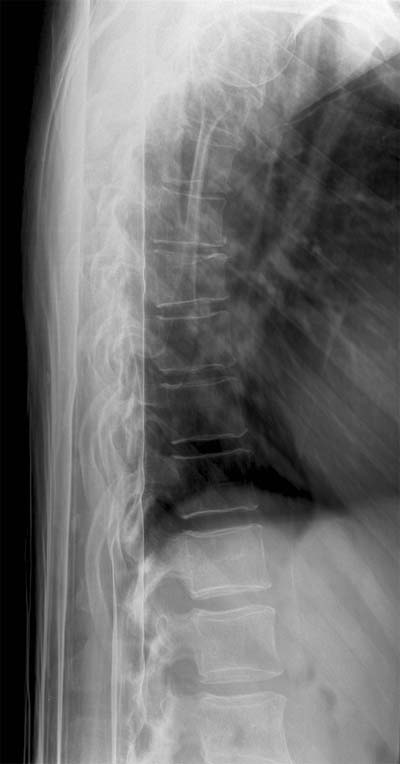.
This is a picture of my spine. It was taken on 21 Feb, after landing at great force on my upper back as I fell from a very wet children’s slide. I have a 10% compression fracture at T8. The fracture will heal after 6 weeks but will remain compressed. The important thing now is to continue moving, but gently, between resting, and to continue lengthening exercises.
I am lucky. This could be so much worse. I am taking drugs to relax the muscles and to relieve the pain. I can read in between sleeping.
There is something beautiful about this image. Is it because it is a picture of something that is actually happening? Is its accuracy what makes it so beautiful? Is it because it is a picture of something I know exists but cannot directly see?
Keats wrote, in Ode to a Grecian Urn, that beauty is truth, truth is beauty, and that is all we know on earth and all we need to know.
Today I am reading about structure in David Bohm’s book, On Creativity.
Bohm talks about the beauty and truth of structures made in art and science. They are beautiful, he suggests, because they reveal understandings of how the world works.
As a human structure made to move, I am learning what motion I am capable of at this point in my life. To me there is beauty in learning what is true.
Bohm suggests that art works and scientific theories are structures that come from ‘the human being as a whole’, and that it is limiting to view art and science as coming only from our ‘imagination’ or ‘reason’. (p. 68)
This makes me think about how I am making Antarctic animations. Is it a whole body process? I feel my way through understanding Antarctica by making animations in response to what I learn from experience and observations.
Animation is an art that structures forms in space and time. Antarctic animations reflect what I have learned about how Antarctica works. The 42 animations, when complete, will be arranged according to their use of time, space and effort. They may also be arranged according to their use of metaphor, language and landscape. They may be arranged in other ways that I cannot yet see.
New interface structures will need to be made to present these findings. I am hoping to come up with structures that reflect the Antarctic environment itself: layered and able to be understood from many different perspectives. I think of antarctica as a huge, multifocal lens that reflects the world views of people who have observed it, and responded to it. I am one of those many people.
I am a part of what I am studying: motion and change observed and experienced.
Antarctic animation contributes to understanding what Bohm and other people say, that the constant factor in our world is motion and change.
Finding ways to represent the reality of climate change is the challenge.
People are working on this problem individually and collectively. New world views are being structured as scientific theories and as art works.
New world views reconnect with ancient knowledge of our selves as part of nature, and reciprocity between living things.


We are, like Antarctica, mostly water
Amen
THis research took a turn at grounding you severly in the reality of the body. It may be a gift from God or lifeforce or universe. I am sending you my blessings. Last time I saw you you were speeding around. I know you were trying explore krill movements…..you can probably use it now even better….opening up spaces between vertebra….
truth and beauty of our amzing body structures … so competent and developed and yet not that different to krill
I like what David Bohm says about our continuity with our total environment, that includes what we learn from each other:
Bohm calls patterns in motion in the natural world (including us) the ‘essence of life’, ‘art’, ‘inner psychological experience’, and ‘organising energy.’
I disagree that this is ‘a new world view.’ It is the Australian aboriginal view, and the view of other cultures and individuals before Bohm.
There are few references, apart from self-references, in Bohm’s book, which is disappointing.
Lisa,
sorry to hear about your spine as well. A definite time of grounding.
I tend to agree with you re-Bohm he draws a lot from Eastern Philosophies/theologies (as do many scientists) and has had a number of dialogues with the Dalai Lama. I feel that this is a missing element in the philosophies of the “dead french guys” (as I call them) and am attempting to address that with my work and my paper. I am looking at Bohm more to fill in the Eastern holes (!?) with some scientific temperament.
At present I am re-reading, for the ?th time, Alan Watt’s “Tao: The Watercourse Way” and which echoes you’re quote with:
“What is that which is always pursued? Answer: yourself. Idealists (in the moral sense of the word) regard the universe as different and separate from themselves-that is, as a system of external objects which needs to be subjugated. Taoists view the universe as the same as, or inseparable from, themselves – so that Lao-tzu could say, “without leaving my house, I know the whole universe.”
Animators are definitely movers ie a whole body process!!!!!! I do not think that you can successfully animate if you can’t move. All the great animators from the past would act out the piece they were attempting to animate.